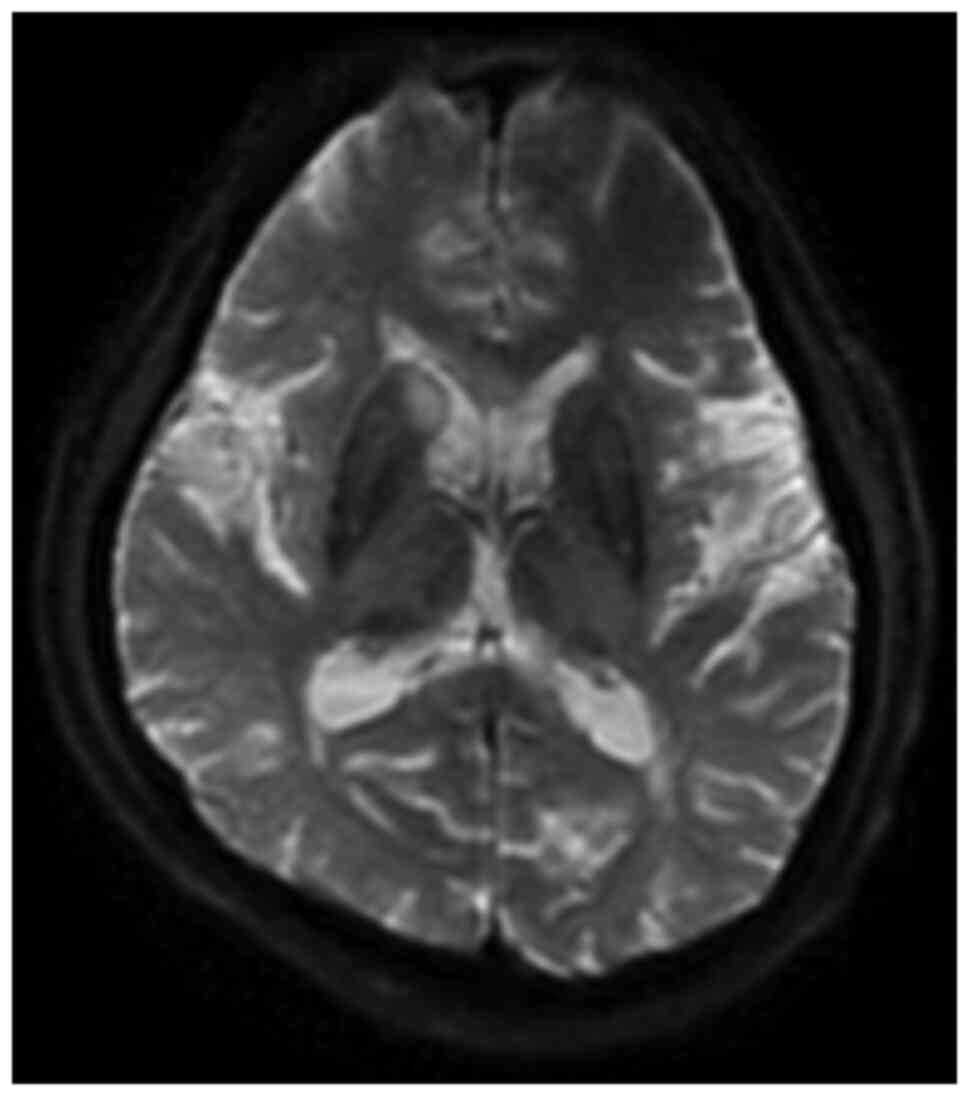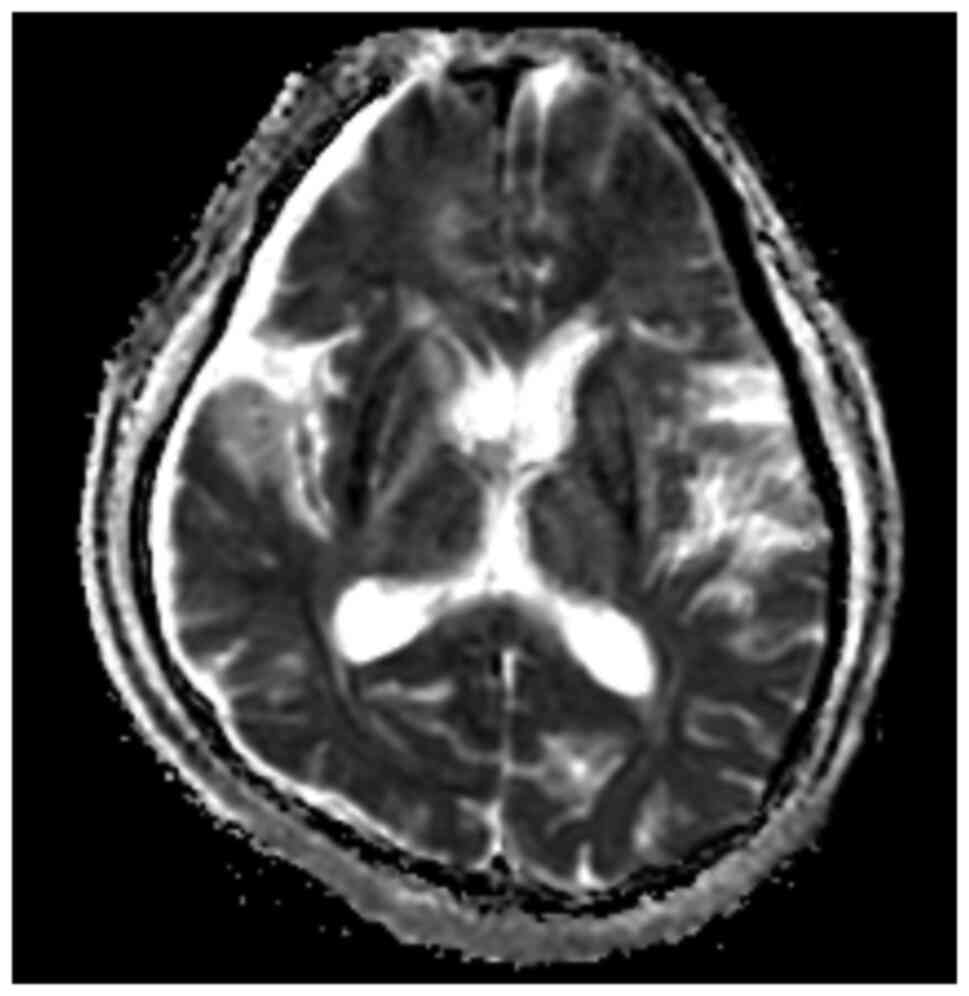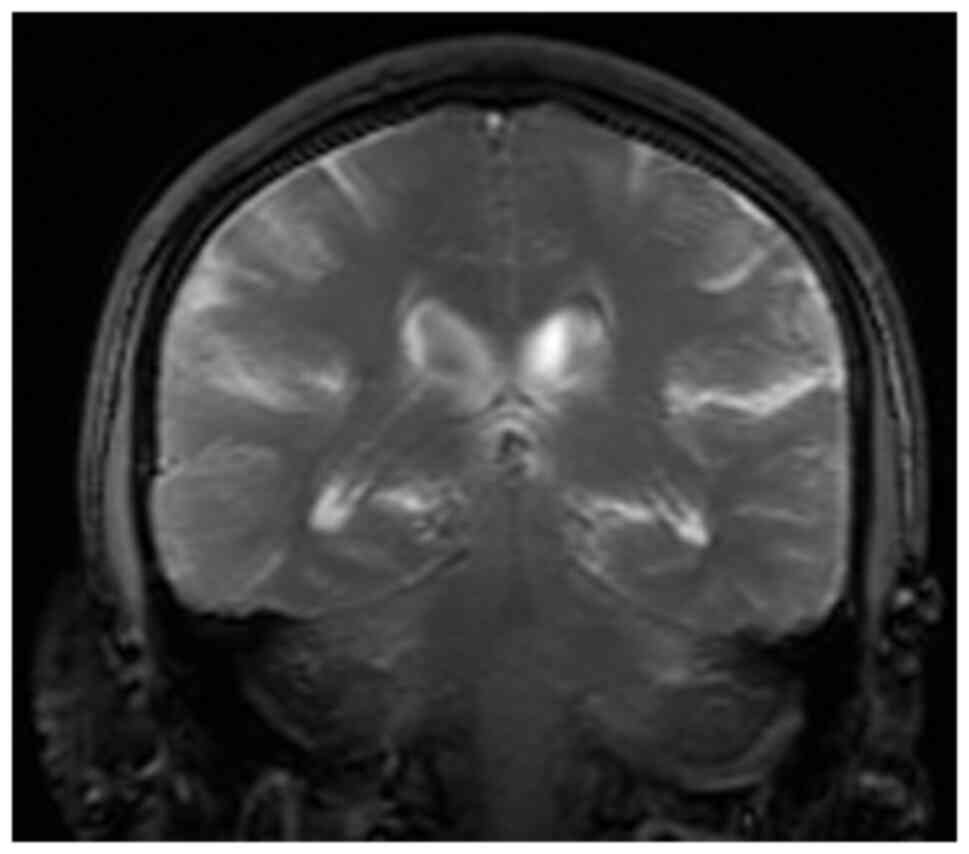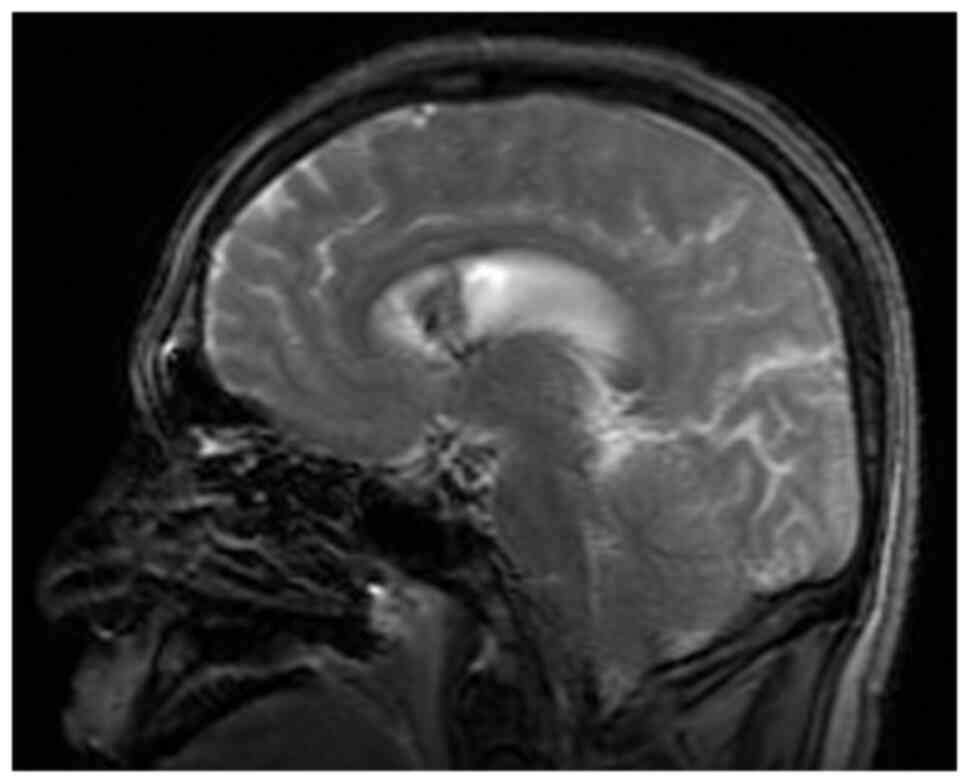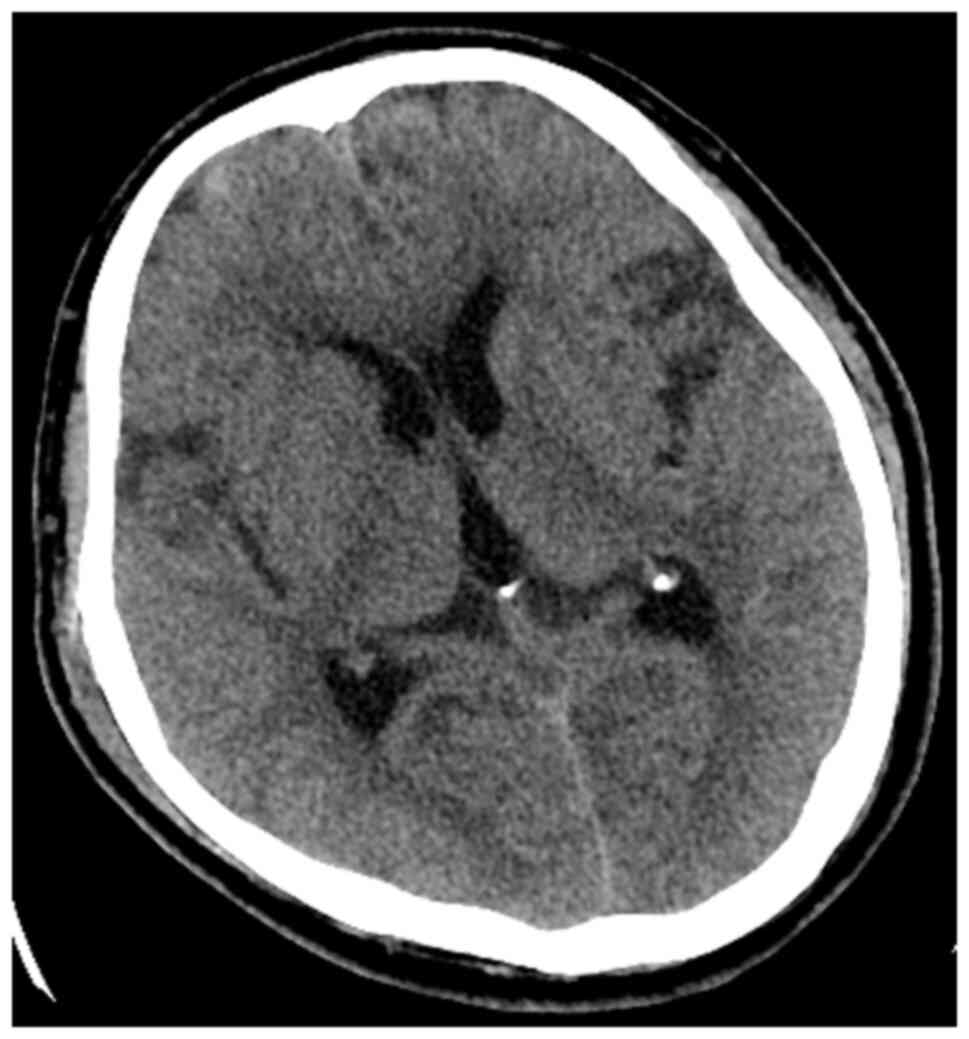Anthrax meningoencephalitis: A case report
- Authors:
- Published online on: November 1, 2024 https://doi.org/10.3892/etm.2024.12759
- Article Number: 9
-
Copyright: © Zhou et al. This is an open access article distributed under the terms of Creative Commons Attribution License.
Abstract
Introduction
Anthrax is a statutory class B infectious disease, an acute zoonotic infectious disease caused by infection with Bacillus anthracis (1). Humans are also susceptible and the main sources of infection are infected animals and their products, as well as contaminated environments. Bacillus anthracis infection can occur through multiple routes, such as the respiratory tract, digestive tract, skin and mucous membranes (2). The main clinical type is cutaneous anthrax, while other types include intestinal anthrax and pulmonary anthrax, which can be secondary to sepsis and meningitis (3). The case fatality rate associated with cutaneous anthrax is low; however, the case fatality rate associated with all other types of anthrax is high (4). The reported incidence of anthrax in the Shandong province of China remains low with 1 case of cutaneous anthrax reported in 2010 and 1 case in 2014. In 2021, there were two cases, and there was a common exposure history of slaughtering sick cattle. The other epidemic consisted of 13 cases. The source of infection was sick cattle, and the route of transmission was slaughtering sick cattle, and being in contact with contaminated equipment and related cattle products. The patients were mainly engaged in cattle slaughtering or cattle product collection and sale-related occupations (5). The present study describes one case of anthrax meningitis admitted to the Second People's Hospital of Liaocheng (Linqing, China), and the investigative and treatment strategies applied are also reported.
Case report
In January 2024, a 55-year-old man was admitted to The Second People's Hospital of Liaocheng (Linqing, China). The patient presented with a fever, rapid heart rate, rapid breathing, high blood pressure, fully unconsciousness, and a tense and painful facial expression. The patient experienced numb limbs and a stiff neck. According to the laboratory results and MRI examination results, the initial diagnosis was encephalitis (considering bacterial or viral infection), and it was necessary to investigate the cause of coma and hypertension. Following admission, the patient received treatment with the dehydration drug mannitol at 0.5 g/kg once every 8 h, an acyclovir injection (5 mg/kg, once every 12 h) against the cold virus, piperacillin sodium/tazobactam sodium injection (75 mg/kg, once every 6 h) as resistance against bacterial infection in the central nervous system (according to clinical experience), dexamethasone injection (10 mg, once a day) to reduce brain edema, and tracheal intubation, mechanical ventilation and sputum aspiration; however, the condition of the patient did not improve (6). Head MRI revealed an abnormal signal in the right caudate nucleus and bilateral hippocampus, indicating encephalitis (Fig. 1, Fig. 2, Fig. 3 and Fig. 4). A brain computed tomography (CT) scan revealed lacunar infarction (Fig. 5). The MRI findings were consistent with mild cerebral arteriosclerosis and localized cerebral artery stenosis (7). For ‘bacterial encephalitis’, the treatment with piperacillin sodium/tazobactam sodium and acyclovir was terminated, and the more sensitive vancomycin combined with meropenem was used for anti-infection treatment according to clinical experience (8).
Cerebrospinal fluid analysis and next generation sequencing (NGS) of the blood metagenome was performed by Yinfeng Gene Technology Co., Ltd. A pPathogenic microorganism targeted gene detection kit was used to prepare DNA/RNA sequencing samples (cat. no. PT001; Nanjing Practical Medical Inspection Co., Ltd.). The concentration and purity of DNA and RNA nucleic acids were determined by Nano-300 micro spectrophotometer (Hangzhou Aosheng Instrument Co., Ltd.), and the integrity of genomic DNA and genomic RNA fragments were analyzed by Agilent 2100 biological analyzer (Agilent Technologies, Inc.). The sequence length was 75 bp and the direction of sequencing was ‘single end’. The FASTASeq 300 sequencing kit V1.0 (FCH-D SE075-D) (100 cycles; cat. no. S000191; Shenzhen Zhenmai Biotechnology Co., Ltd.) was used. The final concentration of the library was 3.6 pM. The data were analyzed by SJ-tNGS software (version 240829; Nanjing Practical Medical Inspection Co., Ltd.). The results showed Bacillus anthracis infection. The number of gene detection sequences in the cerebrospinal fluid was 83,942, and that in the blood was 41. The diagnosis of anthrax meningitis and anthracemia was made.
In the patient of the present study, anthrax meningitis was diagnosed and the patient was immediately isolated in a separate room without contact. At the same time, the Department of Infectious Diseases and the Center for Disease Control and Prevention (Liaocheng, China) were contacted to guide the treatment, and antibiotic treatment was adjusted to vancomycin + meropenem + moxifloxacin combined antibacterial therapy, according to the 2023 version of the anthrax diagnosis and treatment plan (9), and the patient was continued to be treated with dehydration, intracranial pressure reduction, epilepsy prevention and treatment and brain protection. Tracing the route of infection, the patient went to a cattle and sheep butcher's shop 12 days ago to buy mutton to eat himself. Anthrax was detected on the chopping board of the butcher's shop. The patient had a history of cerebrospinal fluid rhinorrhea 5 years ago, a recent history of a cold, sneezing and nasal discharge, and a high possibility of cerebrospinal fluid rhinorrhea prior to infection. Following combined antibacterial therapy, the symptoms were alleviated and combined with the monitoring of blood, cerebrospinal fluid and sputum bacteria, it was considered that the patient had meningitis directly caused by anthrax, and meningitis was the main focus. Considering that the penetration of vancomycin through the blood-brain barrier is poor (10), treatment was changed to the protein synthesis inhibitor linezolid, 600 mg by injection, every 12 h (11), and the infection indicators of the treated patient exhibited a downward trend 3 days later. However, it is not necessary to change the antibacterial drug to linezolid for the treatment of non-meningitis anthrax. The anthrax test was weakly positive, and the meropenem treatment was stopped and downgraded to an intravenous drip of penicillin at 4 million units twice a day. Combined with linezolid, at 600 mg by injection every 12 h, and moxifloxacin, at 400 mg by injection, for antibacterial treatment every day, the condition of the patient markedly improved and the antimicrobial drug was gradually downgraded in the later 14 days, and the results of the cerebrospinal fluid analysis were negative. The biochemical results of the cerebrospinal fluid 33 days after admission showed the following: Cerebrospinal fluid protein, 682 mg/l (normal range, 150-450 mg/l); cerebrospinal fluid sugar, 3.68 mmol/l (normal range, 2.5-4.4 mmol/l) and leukocytes, 29x106/l (normal range, <5x106/l). The results of routine blood tests showed white blood cell levels of 8.29x109/l (normal range, 4-10x109/l) and a neutrophil ratio of 66.3% (normal range, 50-70%). Isolation of the patient was terminated following multidisciplinary consultation. Subsequently, the antibiotic infusion was gradually discontinued and the treatment was switched to single oral moxifloxacin tablets. Following standardized treatment at the hospital, the symptoms of the patient were markedly alleviated and they were discharged. Follow-up was performed once every 2 months after discharge, and the patient is now left with encephalitis sequela, is occasionally fidgety, has had a seizure once and occasionally has vague consciousness.
Discussion
Anthrax is persistent and after entering the 21st century, with the development of animal husbandry and the acceleration of trade circulation, the disease has exhibited an upward trend in a number of areas, endangering animals and threatening human health (10). At present, the diagnosis and treatment of anthrax meningitis still encounters significant challenges (11). Early detection, diagnosis and treatment, as well as the prevention of complications can improve the prognosis of affected patients (12).
With regard to early detection, the anthrax infection in the present patient may have been caused by a contact infection from buying mutton. Patients are exposed to lamb meat with Bacillus anthracis, which may enter the skull through the nose or external auditory canal and cause encephalitis. In the patient described herein, although Bacillus anthracis was not detected in the nasal cavity or external auditory canal of the patient, the patient's history of cerebrospinal fluid rhinorrhea and a history of a ‘cold’ suggest that intracranial infection through the nasal cavity is highly possible. In this case, anthrax was detected in the cerebrospinal fluid and through blood genetic monitoring, and the content of Bacillus anthracis in the cerebrospinal fluid was ample, which led to the diagnosis of anthrax meningitis. The patient had been examined at the village clinic in the early stages of infection and had not received a clear diagnosis, indicating that the local clinicians did not have sufficient knowledge of anthrax, which led to the worsening condition of the patient. Therefore, the local government needs to formulate an intervention plan to carry out comprehensive intervention measures focusing on health education for animal husbandry and animal husbandry workers in the county. In addition, measures are needed to strengthen the training of medical personnel at all levels in the identification, diagnosis and treatment of anthrax on the premise of training in the prevention and control of emerging infectious diseases, so as to improve the ability of early identification and diagnosis of infectious diseases. Joint prevention and control mechanisms are required in order to strengthen the information exchange between health and agriculture departments, animal husbandry, market supervision and public security in order to jointly and effectively prevent and control zoonotic infectious diseases (13). The next step should be to further strengthen the construction of laboratories and improve the ability of case diagnoses and environmental monitoring at the grassroots level.
Early diagnosis and treatment are mandatory. Anthrax meningitis has a rapid onset, mainly with sudden fever, fatigue, dizziness, nausea, vomiting, agitation, seizures, delirium and meningeal irritation (13). The normal white blood cell count in adult peripheral blood is 4-10x109/l, while that of anthrax patients is increased, usually at 10-20x109/l, but reaching as high as 60-80x109/l, and is mainly composed of neutrophils (14). Certain patients have thrombocytopenia. For an etiological and serological examination, specimens of blister fluid, blood, cerebrospinal fluid, pleural effusion and secretions can be collected for testing: i) Bacterial smear: Under the microscope, gram-positive crude bacilli were arranged in series (15); ii) bacterial culture: The collected specimens are inoculated in nutrient agar medium and Bacillus anthracis can be cultured; iii) nucleic acid detection: PCR or quantitative PCR detect the specific nucleic acid of Bacillus anthracis and the results are positive; iv) antigen detection: Bacillus anthracis antigen detection can be performed by immunochromatography; however, a negative result cannot rule out anthrax; v) antibody detection: ELISA and immunochromatography can detect antibodies to blood anthrax toxin antigens and capsular antibodies.
The differential diagnosis of anthrax meningitis includes subarachnoid or intracerebral hemorrhage, bacterial or aseptic meningitis and viral encephalitis; MRI, which was applied in the present case, can easily identify hemorrhagic meningoencephalitis and subarachnoid or intracerebral hemorrhages (16). To distinguish between other hemorrhagic or non-hemorrhagic meningoencephalitis, Gram staining and cultures of the cerebrospinal fluid (17), which were applied in the present case, need to be performed. In cases of subarachnoid hemorrhages, headaches, nausea and vomiting may occur, and meningeal irritation may be present. Cranial CT scans (18), which were applied in the present case, or MRI may indicate subarachnoid hemorrhage, and the lumbar puncture examination of cerebrospinal fluid (19), which was applied in the present case, may reveal homogeneous bloody cerebrospinal fluid. Epidemic meningitis is acute purulent meningitis caused by meningococcal bacteria, and its clinical presentation and cerebrospinal fluid characteristics are similar to those of anthrax meningitis; however, it can be distinguished by etiological testing (20). For instance, common bacteria, such as Staphylococcus aureus and Escherichia coli can also cause bacteremia, and the culture and identification of these bacteria are essential for the differential diagnosis (21). In addition, knowledge of the medical and epidemiological history of the patient is also a key reference for the differential diagnosis. Anthracemia is usually secondary to severe infections, such as cutaneous, enteral or pulmonary anthrax; thus, an investigation to identify any possible history of exposure or medical history can aid doctors in determining whether a person may be infected with Bacillus anthracis (22).
Anthrax meningitis should also be differentiated from rhinosinusal aspergilloma: Common complaints are nasal congestion, a runny nose and olfactory dysfunction. Unilateral and persistent headache, trigeminal neuralgia and unilateral scabs are strong clinical indicators. An endoscopic examination reveals obvious edema or middle nasal polyps. Imaging reveals unilateral maxillary-ethmoidal sinus injury with hyperosteogeny, calcification in the maxillary sinus wall and sinus and obstruction of bone-phlegm complex. The imaging lesions of aspergilloma include the dissolution of aspergilloma and the bone wall of the maxillary sinus, particularly the bone wall of the medial wall, orbital floor and bone septum. A high-resolution CT scan can emphasize erosion. An MRI can also be used to describe tumor obstruction secondary to fluid retention in the sinus cavity. The most common eye and orbit complications are accompanied by orange peel-like tissue in the orbital sinus, particularly severe nosebleeds, severe headaches, possible fever and systemic damage (23).
For anthrax, general treatment includes the following: Strict isolation, bed rest, appropriate fluid replacement to maintain water and electrolyte balance in patients with vomiting, diarrhea and difficulty eating, the appropriate management of hemorrhage, shock and neurological symptoms, and hormonal therapy in patients with severe edema or meningitis (24).
Regarding the treatment of pathogens, Bacillus anthracis is susceptible to β-lactams (penicillin, carbapenems), aminoglycosides, macrolides, fluoroquinolones, tetracyclines, glycopeptides, lincosamides, rifamycins and oxazolidinones, but not to cephalosporins and sulfonamides (25). For anthrax with sepsis and with severe edema, two or more antimicrobial agents active against Bacillus anthracis should be administered, at least one of which has bactericidal activity (26). The first-line regimen is ciprofloxacin and alternative options are levofloxacin, moxifloxacin, meropenem, imipenem, vancomycin, penicillin G and ampicillin (27). At least one other agent is a protein synthesis inhibitor (clindamycin or linezolid as a first-line regimen; doxycycline or rifampicin as alternatives) (28). Anthrax meningitis is treated with at least three antimicrobial agents active against Bacillus anthracis (29). At least one of them is a fungicide (fluoroquinolone or β-lactam) and at least one is a protein synthesis inhibitor; all antimicrobials should have good central nervous system penetration (30). Fluoroquinolone antimicrobials include ciprofloxacin [400 mg intravenously (i.v.) every 8 h] as a first-line option; levofloxacin (750 mg i.v. once a day) or moxifloxacin (400 mg i.v. once a day) as alternatives (31). β-lactam antimicrobials include meropenem (2 g i.v. every 8 h) as a first-line option; penicillin G (4 million units i.v. every 4 h) and ampicillin (3 g i.v. every 6 h) are alternatives (32). Protein synthesis inhibitors include linezolid (600 mg i.v. every 12 h) as a first-line option and clindamycin (900 mg i.v. every 8 h), vancomycin [60 mg/(kg d), administered in three divided doses, maintain serum trough concentration 15-20 mg/l], rifampicin (600 mg i.v. every 12 h) and chloramphenicol (1 g i.v. every 8-6 h) (33). Due to poor central nervous system permeability, doxycycline should not be used as a protein synthesis inhibitor in patients with meningitis (34).
Patients can be discharged after the clinical symptoms have subsided and their secretions or excretions are negative for two consecutive bacterial cultures or nucleic acid tests (24 h apart). Anthrax meningitis has a mortality rate of almost 100% and is a complication of anthrax exposure. Meningitis can be primary (i.e., no obvious route of transmission) or secondary (i.e., complications of any other form of anthrax). Meningitis occurs in 14-37% of patients infected with anthrax via injection, ingestion, the systemic cutaneous route or via inhalation, depending on the route of transmission (3). Therefore, all patients with signs or symptoms of systemic disease need to be evaluated for meningitis. In the clinical diagnosis and treatment, the positive rate of traditional cerebrospinal fluid culture is not high, and the special flora is not easy to culture, while cerebrospinal fluid gene detection covers a wide range. In the case of the present study, no bacteria were detected in the cerebrospinal fluid culture and the results of cerebrospinal fluid and blood metagenomic sequencing (NGS) in the early stage revealed infection with Bacillus anthracis, and pathogen-specific treatment was administered: Fluoroquinolone antimicrobials, β-lactam antimicrobials and protein synthesis inhibitors were combined for antibacterial therapy. The treatment effect was satisfactory and the anthrax culture was negative; thus, the antimicrobial drug was gradually tapered and the condition of the patient improved and he was discharged from the hospital.
In terms of the prevention of epidemics, studies have shown that the public's awareness of epidemic prevention may determine the probability of an anthrax epidemic in humans; strengthening the conveyance of anthrax knowledge may be the key measure to prevent and control an epidemic (35). It has been suggested that the health education of farmers and herdsmen on anthrax prevention and control should be strengthened as soon as possible, so that herdsmen can develop the hygienic concept and behavior of ‘not slaughtering, dissecting and not eating sick and dead livestock’ (36). Animal husbandry and veterinary departments shall strengthen grassroots technical forces and legal publicity measures, and strengthen the monitoring of epidemic situations among animals. Immediately following an outbreak of inter-livestock anthrax, the trading market should be closed. The dead livestock should be properly handled, such as the incineration or deep burial of livestock that have died of the disease, so as to control the spread of the inter-livestock epidemic as soon as possible, and fundamentally cut off the transmission route, in order to avoid the occurrence of human epidemics (37). In this outbreak, due to the fact that the patient described herein and his family did not understand the dangers of anthrax and the village doctor was not highly vigilant, it was not possible to make a positive diagnosis and perform treatment at an early stage. Therefore, strengthening the professional knowledge training of county, township (town) health centers and village doctors, and improving their clinical diagnosis and treatment capabilities should be the focus of medical and health work in agricultural and pastoral areas in the future.
The present case report has certain limitations, which should be mentioned. First, it only describes one case, and this disease is known to appear in a number of forms. In addition, the patient came to the hospital for reexamination regularly, but the follow-up period after discharge was only 7 months.
In conclusion, anthrax meningoencephalitis is a rare central nervous system complication of anthrax, which progresses rapidly following the onset of the disease; timely treatment needs to be administered in order to prevent the high disability and mortality rates associated with his type of infection. Early detection, early diagnosis and early treatment are of particular importance for patients with anthrax meningoencephalitis and strengthening epidemic prevention is also a key task. The present study shares the diagnosis and treatment of a case of anthrax meningitis with an aim to provide experience and advice regarding anthrax prevention and treatment.
Acknowledgements
Not applicable.
Funding
Funding: No funding was received.
Availability of data and materials
The data generated in the present study may be requested from the corresponding author.
Authors' contributions
KL and LZ conceived and designed the study. ZC and XY analyzed and summarized the data and wrote the manuscript. KL, ZC and LZ collected the laboratory examination data and MRI images of the case. XY critically revised the manuscript. KL and LZ confirm the authenticity of all the raw data. All authors read and approved the final manuscript.
Ethics approval and consent to participate
This study was conducted in accordance with the principles expressed in the Declaration of Helsinki.
Patient consent for publication
The patient involved in the present study was subjected to standard clinical practice and provided written informed consent for the publication of medical data and images.
Competing interests
The authors declare that they have no competing interests.
References
|
Tschopp R and Kidanu AG: Knowledge-attitude and practice of Anthrax and brucellosis: Implications for zoonotic disease surveillance and control in pastoral communities of Afar and Somali region, Ethiopia. PLoS Negl Trop Dis. 18(e0012067)2024.PubMed/NCBI View Article : Google Scholar | |
|
Nana SD, Caffin JH, Duboz R, Antoine-Moussiaux N, Binot A, Diagbouga PS, Hendrikx P and Bordier M: Towards an integrated surveillance of zoonotic diseases in Burkina Faso: The case of anthrax. BMC Public Health. 22(1535)2022.PubMed/NCBI View Article : Google Scholar | |
|
Bradley JS, Bulitta JB, Cook R, Yu PA, Iwamoto C, Hesse EM, Chaney D, Yu Y, Kennedy JL, Sue D, et al: Central nervous system antimicrobial exposure and proposed dosing for anthrax meningitis. Clin Infect Dis. 78:1451–1457. 2024.PubMed/NCBI View Article : Google Scholar | |
|
Blackburn JK, Kenu E, Asiedu-Bekoe F, Sarkodie B, Kracalik IT, Bower WA, Stoddard RA and Traxler RM: High case-fatality rate for human anthrax, Northern Ghana, 2005-2016. Emerg Infect Dis. 27:1216–1219. 2021.PubMed/NCBI View Article : Google Scholar | |
|
Zhang EM, Zhang HJ, He JR, Li W and Wei JC: Analysis of epidemic characteristics of anthrax in China from 2017 to 2019 and molecular typing of Bacillus anthracis. Zhonghua Yu Fang Yi Xue Za Zhi. 56:422–426. 2022.PubMed/NCBI View Article : Google Scholar : (In Chinese). | |
|
Caffes N, Hendricks K, Bradley JS, Twenhafel NA and Simard JM: Anthrax meningoencephalitis and intracranial hemorrhage. Clin Infect Dis. 75 (Suppl 3):S451–S458. 2022.PubMed/NCBI View Article : Google Scholar | |
|
Zhou G, Wang H, Zhang X, Yu L, Yao F, Li B and Fang Q: Cerebral arteriosclerosis stenosis predicts poor short-term prognosis in non-valvular atrial fibrillation related cardioembolic stroke treated by reperfusion therapy. Clin Neurol Neurosurg. 207(106738)2021.PubMed/NCBI View Article : Google Scholar | |
|
Gozdas HT, Dogan A, Wright H and Fox-Lewis A: Laboratory findings in acute bacterial meningitis and acute viral encephalitis. N Z Med J. 137:103–104. 2024.PubMed/NCBI View Article : Google Scholar | |
|
Bhattacharya D, Kshatri JS, Choudhary HR, Parai D, Shandilya J, Mansingh A, Pattnaik M, Mishra K, Padhi SP, Padhi A and Pati S: One Health approach for elimination of human anthrax in a tribal district of Odisha: Study protocol. PLoS One. 16(e0251041)2021.PubMed/NCBI View Article : Google Scholar | |
|
Zhang H, Zhang E, Guo M, He J, Li W and Wei J: Epidemiological characteristics of human Anthrax - China, 2018-2021. China CDC Wkly. 4:783–787. 2022.PubMed/NCBI View Article : Google Scholar | |
|
Kutmanova A, Zholdoshev S, Roguski KM, Sholpanbay Uulu M, Person MK, Cook R, Bugrysheva J, Nadol P, Buranchieva A, Imanbaeva L, et al: Risk factors for severe cutaneous anthrax in a retrospective case series and use of a clinical algorithm to identify likely meningitis and evaluate treatment outcomes, kyrgyz republic, 2005-2012. Clin Infect Dis. 75 (Suppl 3):S478–S486. 2022.PubMed/NCBI View Article : Google Scholar | |
|
Thompson JM, Cook R, Person MK, Negrón ME, Traxler RM, Bower WA and Hendricks K: Risk factors for death or meningitis in adults hospitalized for cutaneous anthrax, 1950-2018: A systematic review. Clin Infect Dis. 75 (Suppl 3):S459–S467. 2022.PubMed/NCBI View Article : Google Scholar | |
|
Sidwa T, Salzer JS, Traxler R, Swaney E, Sims ML, Bradshaw P, O'Sullivan BJ, Parker K, Waldrup KA, Bower WA and Hendricks K: Control and Prevention of Anthrax, Texas, USA, 2019. Emerg Infect Dis. 26:2815–2824. 2020.PubMed/NCBI View Article : Google Scholar | |
|
Ben-Shmuel A, Glinert I, Sittner A, Bar-David E, Schlomovitz J, Levy H and Weiss S: Doxycycline, levofloxacin, and moxifloxacin are superior to ciprofloxacin in treating anthrax meningitis in rabbits and NHP. Antimicrob Agents Chemother: Apr 30, 2024 (Epub ahead of print). | |
|
Wicky PH, Poiraud J, Alves M, Patrier J, d'Humières C, Lê M, Kramer L, de Montmollin É, Massias L, Armand-Lefèvre L and Timsit JF: Cefiderocol treatment for severe infections due to difficult-to-treat-resistant non-fermentative Gram-Negative Bacilli in ICU patients: A case series and narrative literature review. Antibiotics (Basel). 12(991)2023.PubMed/NCBI View Article : Google Scholar | |
|
Zhou ZM, Gu LL, Zhou ZY and Liang QL: Recent Advance of S100B proteins in spontaneous intracerebral hemorrhage and aneurysmal subarachnoid hemorrhage. Front Biosci (Landmark Ed). 29(37)2024.PubMed/NCBI View Article : Google Scholar | |
|
Bobinger T, Roeder SS, Spruegel MI, Froehlich K, Beuscher VD, Hoelter P, Lücking H, Corbeil D and Huttner HB: Variation of membrane particle-bound CD133 in cerebrospinal fluid of patients with subarachnoid and intracerebral hemorrhage. J Neurosurg. 134:600–607. 2021.PubMed/NCBI View Article : Google Scholar | |
|
Zhao X, Zhou B, Luo Y, Chen L, Zhu L, Chang S, Fang X and Yao Z: CT-based deep learning model for predicting hospital discharge outcome in spontaneous intracerebral hemorrhage. Eur Radiol. 34:4417–4426. 2024.PubMed/NCBI View Article : Google Scholar | |
|
Conklin J and Lev MH: Beyond the AJR: Intracranial CTA versus lumbar puncture for suspected subarachnoid hemorrhage with negative head CT. AJR Am J Roentgenol: Jul 17, 2024 (Epub ahead of print). | |
|
Li JH, Wu D, Yin ZD and Li YX: Analysis of epidemic characteristics for meningococcal meningitis in China during 2015-2017. Zhonghua Yu Fang Yi Xue Za Zhi. 53:159–163. 2019.PubMed/NCBI View Article : Google Scholar : (In Chinese). | |
|
Bita Fouda AA, Latt A, Sinayoko A, Mboussou FFR, Pezzoli L, Fernandez K, Lingani C, Miwanda B, Bulemfu D, Baelongandi F, et al: The bacterial meningitis epidemic in banalia in the democratic republic of congo in 2021. Vaccines (Basel). 12(461)2024.PubMed/NCBI View Article : Google Scholar | |
|
Zhai LN, Zhao Y, Song XL, Qin TT, Zhang ZJ, Wang JZ, Sui CY, Zhang LL, Lv M, Hu LF, et al: Inhalable vaccine of bacterial culture supernatant extract mediates protection against fatal pulmonary anthrax. Emerg Microbes Infect. 12(2191741)2023.PubMed/NCBI View Article : Google Scholar | |
|
Vrinceanu D, Dumitru M, Patrascu OM, Costache A, Papacocea T and Cergan R: Current diagnosis and treatment of rhinosinusal aspergilloma (Review). Exp Ther Med. 22(1264)2021.PubMed/NCBI View Article : Google Scholar | |
|
Beliveau M, Rubets I, Bojan D, Hall C, Toth D, Kodihalli S and Kammanadiminti S: Animal-to-Human dose translation of ANTHRASIL for treatment of inhalational anthrax in healthy adults, obese adults, and pediatric subjects. Clin Pharmacol Ther. 115:248–255. 2024.PubMed/NCBI View Article : Google Scholar | |
|
Doganay M, Dinc G, Kutmanova A and Baillie L: Human Anthrax: Update of the diagnosis and treatment. Diagnostics. 13(1056)2023.PubMed/NCBI View Article : Google Scholar | |
|
Person MK, Cook R, Bradley JS, Hupert N, Bower WA and Hendricks K: Systematic review of hospital treatment outcomes for naturally acquired and bioterrorism-related anthrax, 1880-2018. Clin Infect Dis. 75 (Suppl 3):S392–S401. 2022.PubMed/NCBI View Article : Google Scholar | |
|
Bower WA, Yu Y, Person MK, Parker CM, Kennedy JL, Sue D, Hesse EM, Cook R, Bradley J, Bulitta JB, et al: CDC guidelines for the prevention and treatment of anthrax, 2023. MMWR Recomm Rep. 72:1–47. 2023.PubMed/NCBI View Article : Google Scholar | |
|
Matharoo K, Chua J, Park JR, Ingavale S, Jelacic TM, Jurkouich KM, Compton JR, Meinig JM, Chabot D, Friedlander AM and Legler PM: Engineering an Fc-Fusion of a capsule degrading enzyme for the treatment of anthrax. ACS Infect Dis. 8:2133–2148. 2022.PubMed/NCBI View Article : Google Scholar | |
|
Lin C, Dou X, Zhang D, Sun Y, Han H, Chen C, Zhang X, Li S, Chen Y, Zhang H, et al: Epidemiological Investigation of an Inhalational Anthrax Patient Traveling for Medical Treatment in Beijing Municipality, China, August 2021. China Cdc Wkly. 4:4–7. 2022.PubMed/NCBI View Article : Google Scholar | |
|
Hesse EM, Godfred-Cato S and Bower WA: Antitoxin use in the prevention and treatment of anthrax disease: A systematic review. Clin Infect Dis. 75 (Suppl 3):S432–S440. 2022.PubMed/NCBI View Article : Google Scholar | |
|
Aktories K: Treatment of ovarian cancer with modified anthrax toxin. Proc Natl Acad Sci USA. 119(e2210179119)2022.PubMed/NCBI View Article : Google Scholar | |
|
Martchenko Shilman M, Bartolo G, Alameh S, Peterson JW, Lawrence WS, Peel JE, Sivasubramani SK, Beasley DWC, Cote CK, Demons ST, et al: In vivo activity of repurposed amodiaquine as a host-targeting therapy for the treatment of anthrax. ACS Infect Dis. 7:2176–2191. 2021.PubMed/NCBI View Article : Google Scholar | |
|
Legler PM, Little SF, Senft J, Schokman R, Carra JH, Compton JR, Chabot D, Tobery S, Fetterer DP, Siegel JB, et al: Treatment of experimental anthrax with pegylated circularly permuted capsule depolymerase. Sci Transl Med. 13(eabh1682)2021.PubMed/NCBI View Article : Google Scholar | |
|
Jauro S, Ndumnego OC, Ellis C, Buys A, Beyer W and Heerden HV: Immunogenicity and protective efficacy of a non-living anthrax vaccine versus a live spore vaccine with simultaneous penicillin-G treatment in cattle. Vaccines (Basel). 8(595)2020.PubMed/NCBI View Article : Google Scholar | |
|
Oh J, Jo H, Park J, Lee H, Kim HJ, Lee H, Kang J, Hwang J, Woo S, Son Y, et al: Global burden of vaccine-associated rheumatic diseases and their related vaccines, 1967-2023: A comprehensive analysis of the international pharmacovigilance database. Int J Rheum Dis. 27(e15294)2024.PubMed/NCBI View Article : Google Scholar | |
|
Schneider SN, Nguyen TQ, Hake KL, Nightingale BS, Mangan TP, Rice AN and Carroll JC: Development of a pharmacy point-of-dispensing toolkit for anthrax post-exposure prophylaxis for allegheny county postal workers. J Public Health Manag Pract. 30:231–239. 2024.PubMed/NCBI View Article : Google Scholar | |
|
Li S, Ma Q, Chen H, Liu Y, Yao G, Tang G and Wang D: Epidemiological investigation and etiological analysis of a cutaneous anthrax epidemic caused by Butchering Sick Cattle in Guizhou, China. Front Public Health. 8(65)2020.PubMed/NCBI View Article : Google Scholar |



